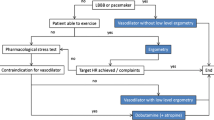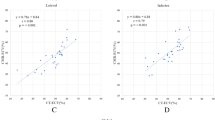Abstract
Background
99mTc-labeled Q12 (99mTc-Q12) is a new imaging agent that produces myocardial visualization in humans. This study examined the hypothesis that a 100-minute rest-exercise tomographic imaging protocol after injection of99mTc-Q12 can be used to detect the presence or absence of coronary artery stenoses.
Methods and Results
Imaging with201Tl and99mTc-Q12 was performed in 20 patients with angiographically documented coronary artery disease and 10 “normal” subjects including two patients with chest pain and normal coronary arteriograms and eight subjects with a very low likelihood of occlusive coronary disease.99mTc-Q12 was imaged beginning 15 minutes after injection at rest and with exercise. In the 20 patients, a corresponding myocardial defect was detected in blinded fashion in 18 with201Tl and 17 with99mTc-Q12 (difference not significant). Of 10 patients without evidence of coronary disease, nine had a normal201Tl scan and eight had a normal99mTc-Q12 scan (difference not significant). Agreement of99mTc-Q12 and201Tl imaging for detection of regional myocardial perfusion defects was excellent (κ=0.88). Identification of the presence or absence of angiographically documented coronary disease in individual coronary artery distributions was 80% and 82% for201Tl imaging and 73% and 87% for99mTc-Q12 (difference not significant).
Conclusion
99mTc-Q12, used in a rest-exercise sequence that can be completed in 100 minutes, provided identification of regional myocardial perfusion defects similar to that of201Tl.
Similar content being viewed by others
References
Ritchie JL, Zaret BL, Strauss HW, et al. Myocardial imaging with thallium-201: a multicenter study in patients with angina pectoris or acute myocardial infarction. Am J Cardiol 1978;42:345–50.
Dunn RF, Wolff L, Wagner S, Botvinick EH. The inconsistent pattern of thallium defects: a clue to the false positive perfusion scintigram. Am J Cardiol 1981;48:224–32.
Deutsch E, Bushong W, Glavan KA, et al. Heart imaging with cationic complexes of technetium. Science 1981;214:85–6.
Gerson MC, Deutsch EA, Nishiyama H, et al. Myocardial perfusion imaging with99mTc-DMPE in man. Eur J Nucl Med 1983;8:371–4.
Wackers FJT, Berman DS, Maddahi J, et al. Technetium-99m hexakis 2-methoxyisobutyl isonitrile: human biodistribution, dosimetry, safety, and preliminary comparison to thallium-201 for myocardial perfusion imaging. J Nucl Med 1989;30:301–11.
Taillefer R, Lambert R, Essiambre R, Phaneuf DC, Leveille J. Comparison between thallium-201, technetium-99m-sestamibi and technetium-99m-teboroxime planar myocardial perfusion imaging in detection of coronary artery disease. J Nucl Med 1992;33:1091–8.
Seldin DW, Johnson LL, Blood DK, et al. Myocardial perfusion imaging with technetium-99m SQ30217: comparison with thallium-201 and coronary anatomy. J Nucl Med 1989;30:312–9.
Hendel RC, McSherry B, Karimeddini M, Leppo JA. Diagnostic value of a new myocardial perfusion agent, teboroxime (SQ 30,217), utilizing a rapid planar imaging protocol: preliminary results. J Am Coll Cardiol 1990;16:855–61.
Jain D, Wackers FJT, Mattera J, McMahon M, Sinusas AJ, Zaret BL. Biokinetics of technetium-99m-tetrofosmin: myocardial perfusion imaging agent: implications for a one-day imaging protocol. J Nucl Med 1993;34:1254–9.
Higley B, Smith FW, Smith T, et al. Technetium-99m-1,2-bis[bis(2-ethoxyethyl)phosphino]ethane: human biodistribution, dosimetry and safety of a new myocardial perfusion imaging agent. J Nucl Med 1993;34:30–8.
Deutsch E, Marmion M, Kwiatkowski M, et al. Synthesis and biodistribution of a new class of 99m-Tc myocardial perfusion agents with optimized imaging properties [Abstract]. Eur J Nucl Med 1991;18:537.
Rossetti C, Vanoli G, Paganelli G, et al. Evaluation in humans of a new tracer with optimized properties for myocardial perfusion imaging: [Tc-99m] Q12 [Abstract]. Eur J Nucl Med 1991;18:540.
Colombo F, Marmion M, Deutsch K, et al. A new cationic agent (Q-12) for myocardial perfusion studies [Abstract]. Eur J Nucl Med 1992;19:739.
Gerson MC, Millard RW, Roszell N, et al. Kinetic properties of Tc-99m Q12 in canine myocardium. Circulation 1994;89:1291–300.
Bruce RA, Kusumi F, Hosmer D. Maximal oxygen intake and nomographic assessment of functional aerobic impairment in cardiovascular disease. Am Heart J 1973;85:546–62.
Prigent FM, Maddahi J, Garcia E, et al. Thallium-201 stress-redistribution myocardial rotational tomography: development of criteria for visual interpretation. Am Heart J 1985;109:274–81.
Dilsizian V, Rocco TP, Freedman NMT, Leon MB, Bonow RO. Enhanced detection of ischemic but viable myocardium by the reinjection of thallium after stress-redistribution imaging. N Engl J Med 1990;323:141–6.
Friedman J, Van Train K, Maddahi J, et al. “Upward creep” of the heart: a frequent source of false-positive reversible defects during thallium-201 stress-redistribution SPECT. J Nucl Med 1989;30:1718–22.
Rohe RC, Thomas SR, Cummings DD, Deutsch EA, Gerson MC, Maxon HR. Organ uptake and biodistribution studies of Tc-99m-Q3, a new myocardial imaging agent [Abstract]. J Nucl Med 1993;34:156P.
Thomas SR, Maxon HR, Kereiakes JG. In-vivo quantitation of lesion radioactivity using external counting methods. Med Phys 1976;3:253–5.
Fleming JG. A technique for the absolute measurement of activity using a gamma camera and computer. Phys Med Biol 1979;24:179–80.
SAAM/CONSAM, a program for multi-compartment kinetic analysis. Seattle: Resource Facility for Kinetic Analysis, Center for Bioengineering, University of Washington. Version 30, 1990.
International Commission on Radiation Protection. Limits for intake by radiation workers. ICRP publication 30. New York: Pergamon Press, 1979.
Stabin M. MIRDOSE3: the PC and MAC-based program for MIRD calculations in adults, children, and pregnant women. Health Phys 1993;64(suppl):S35.
Gerson MC, Khoury JC, Hertzberg VS, Fischer EE, Scott RC. Prediction of coronary artery disease in a population of insulin-requiring diabetic patients: results of an 8-year follow-up study. Am Heart J 1988;116:820–6.
Garcia EV, Van Train K, Maddahi J, et al. Quantification of rotational thallium-201 myocardial tomography. J Nucl Med 1985;26:17–26.
DeRosch MA, Brodack JW, Grummon GD, et al. Kit development for the Tc-99m myocardial imaging agent TechneCard [Abstract]. J Nucl Med 1992;33:850.
Sridhara BS, Braat S, Rigo P, Itti R, Cload P, Lahiri A. Comparison of myocardial perfusion imaging with technetium-99m tetrofosmin versus thallium-201 in coronary artery disease. Am J Cardiol 1993;72:1015–9.
The Tetrofosmin Study Group. Comparative myocardial perfusion imaging with Tc-99m tetrofosmin and thallium-201: results of phase-III international trial [Abstract]. Circulation 1992;86(suppl):I-506.
Cuocolo A, Pace L, Ricciardelli B, Chiariello M, Trimarco B, Salvatore M. Identification of viable myocardium in patients with chronic coronary artery disease: comparison of thallium-201 scintigraphy with reinjection and technetium-99m-methoxyisobutyl isonitrile. J Nucl Med 1992;33:505–11.
Bonow RO, Dilsizian V, Cuocolo A, Bacharach SL. Identification of viable myocardium in patients with chronic coronary artery disease and left ventricular dysfunction: comparison of thallium scintigraphy with reinjection and PET imaging with18F-fluorodeoxyglucose. Circulation 1991;83:26–37.
Dilsizian V, Rocco TP, Freedman NMT, Leon MB, Bonow RO. Enhanced detection of ischemic but viable myocardium by the reinjection of thallium after stress-redistribution imaging. N Engl J Med 1990;323:141–6.
Ohtani H, Tamaki N, Yonekura Y, et al. Value of thallium-201 reinjection after delayed SPECT imaging for predicting reversible ischemia after coronary artery bypass grafting. Am J Cardiol 1990;66:394–9.
Dilsizian V, Freedman NMT, Bacharach SL, Perrone-Filardi P, Bonow RO. Regional thallium uptake in irreversible defects: magnitude of change in thallium activity after reinjection distinguishes viable from nonviable myocardium. Circulation 1992;85:627–34.
Author information
Authors and Affiliations
Additional information
Radiation dose estimates were supplied by Michael G. Stabin, ME, of the Radiation Internal Dose Information Center, Oak Ridge, Tenn.
Rights and permissions
About this article
Cite this article
Gerson, M.C., Lukes, J., Deutsch, E. et al. Comparison of technetium 99m Q12 and thallium 201 for detection of angiographically documented coronary artery disease in humans. J Nucl Cardiol 1, 499–508 (1994). https://doi.org/10.1007/BF02939972
Received:
Accepted:
Issue Date:
DOI: https://doi.org/10.1007/BF02939972




